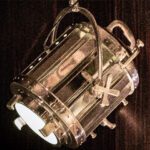The Evolution of Circular Connectors
To meet the need for higher-speed data collection, transmission, and storage, circular connectors are downsizing to serve changes in instrument and product designs. Omnetics’ Bob Stanton traces the evolution of circular connectors, and forecasts future developments in high-speed systems.
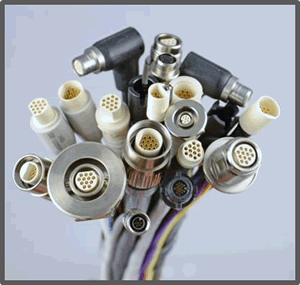 Today’s electronic circuitry is changing rapidly to meet our demand for higher-speed data collection, transmission, and storage. As a result, circular connectors are downsizing to serve changes in instrument and product designs. From applications as varied as surveillance in military to image clarity in medical, information must be quickly collected, transmitted, and disseminated. Miniaturized connectors with pins at .050″ and .025″ center-to-center pitch are utilized during assembly or within the cable system to manage the signals. As data rates increase and connector size decreases simultaneously, circuits are very susceptible to electrical noise and crosstalk between signals.
Today’s electronic circuitry is changing rapidly to meet our demand for higher-speed data collection, transmission, and storage. As a result, circular connectors are downsizing to serve changes in instrument and product designs. From applications as varied as surveillance in military to image clarity in medical, information must be quickly collected, transmitted, and disseminated. Miniaturized connectors with pins at .050″ and .025″ center-to-center pitch are utilized during assembly or within the cable system to manage the signals. As data rates increase and connector size decreases simultaneously, circuits are very susceptible to electrical noise and crosstalk between signals.
Shielded Miniature Circular Connectors
As critical data rates increase, we will need to shield direct-wired cabling to prevent signal noise damage. This is a critical step in protecting circuits from outside listening and pirating sources, as well as noise inside the instrument. At the same time, as the data rates increase, lower voltages reduce signal sizes. This extends battery life but also requires better signal integrity and requires the connector and cable designer to ensure that interconnections evolve to achieve the improved performance necessary to sustain information accuracy. To do this, we see a dramatic evolution in miniature cable and connector technology.
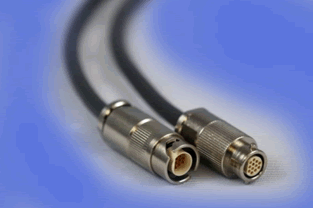
Shielded metal nano connectors
This challenge has come upon us rapidly, as we focus on more portable, lightweight, and rugged connectors that perform at higher circuit speeds. New materials, new design techniques, and new assembly processes will drive us toward our goals. Miniature and ultraminiature cables and connectors will enable multi-use instruments and products as well as direct interconnections in minute systems. Some standard shell and cable formats will evolve, but we will also see rapid design and development of tailored connection schemes using multi-format signal connections. These mixed-signal miniature connectors will also be used to reduce the number of wired cables running from instrument to instrument. In short, there will be fewer cable and connectors per instrument, but an increase in miniature, short-run cable carrying higher and higher data rate signals that need to be designed well and protected from outside interference.
Circuit Evolution
Circuit chips are running faster, instruments and modules can do more in smaller spaces at lower voltages, and current levels are down to milliamps. Portable applications abound from prosthetics and robotics to hand-launched military unmanned vehicles. New cable and connector designs are used to assist in data acquisition, sensing, seeing and routing, and sending critical information at higher speeds in evermore rugged and critical-environment situations. To serve the rapidly changing circuit environment, cables and connectors are also changing in size and shape, and adapting to a variety of levels of reliability. Mixing signals within one connector has existed for years, but is now key to the size challenges in new board and instrument designs.
Connector and Cable Systems Change
The leading edge for many newer designs began with the consumer industry. Following the onset of portable devices from cellular phones and tablets to high-tech toys and gadgets in hunting gear, photography, and even farming technology, demand grew for more rugged environmental applications in military and industrial applications, so connector designers packaged consumer products into large ruggedized housings. This temporary stop-gap measure did not address the need for smaller, lighter, and more flexible components, however: Cables were still too large and stiff and connectors weighed more than many circuits serving them. Fortunately, the lower current and voltage requirements on new chips allowed for smaller wire gauges and connectors.
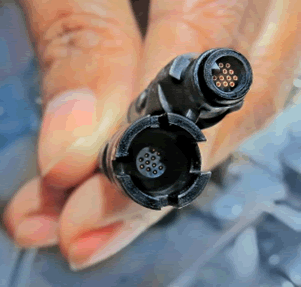
Quick-connect nano connectors
Simultaneously, however, circuit speed quickly increased and demand for higher speeds fueled the appetite for more data, faster. Analog circuitry, with its appetite for higher voltages and currents, began giving way to digital signal transmission. Low-voltage differential signal transmission led the way into higher-speed digital signal methods. This expanded the use of many technologies, such as the sensor and detector industries. Minute tactile sensors could now assist robotic hands, and direct neural interface circuits could be used in medical products. Also, the new camera chips could offer higher resolution at faster frame rates for surveillance equipment. The new digital differential signal era bloomed rapidly. Cable and connectors were designed to meet the new circuit processing methods. Signals got smaller, faster, and cleaner, and new IEEE standards emerged for designers to use universally. These standards are today’s foundation for higher-speed digital electronics that serve an ever-increasing percentage of the total connector and cable markets.
Micro and Nano Circular Connectors for USB 3.0 Speeds
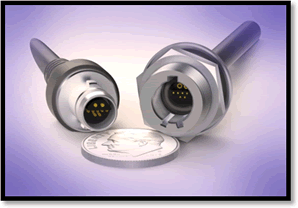
USB 3.0 speed micro connectors
By design, circular connectors are shaped to handle round cabling from high-speed digital as well as analog and power systems, although a large portion of the industry still uses rectangular connectors for cable-to-board interface systems as well as some instrument panel-to-device equipment. Miniature circular connectors are replacing many of these to meet portable equipment needs for flexibility and compact design. Specifically, many new designs are ideal for use in differential signal wiring. As circuit speed increases to USB 3.0 (5Gb/s) rates and higher, the older rectangular connector designs are useful but often too large to serve handheld probes, sensors, detectors, and processors. Micro lead wires and connectors can be more easily handled when used in sensitive applications.
Miniature and Ultraminiature Circular Connector Size Reduction
We have seen rapid change from the older 38999 standards at 100mm pitch down to a 75mm pitch circular connector to accommodate higher-power systems, which are no longer needed everywhere. Now there is another downward-sizing trend to 50mm pitch circular connectors as well as other 25mm pitch sizes. Power-pin elements are designed to fit into miniature connectors to carry power supply currents in parallel with higher-speed signal pins. This use of mixed-signal design inside the cable and connectors significantly reduces size and weight. Use of special insulators and new materials allows the combination of very-high-speed digital signals and power within the same circular shell. Now 5G speeds and higher are being served in circular connectors that fit new forms and functions in this evolving world of portable and miniaturized circuitry.
New Miniature Circular Connectors Checklist
A first step in selecting micro and nano circular connectors is to review the design requirements of the system. Often a simple checklist helps significantly:
- Size – Room to mate and de-mate at a reduced size
- Cable type and shape – Diameter of cable to enter back of the connector
- Mate/de-mate method – Designed for ease and speed or rugged connection?
- Circuit – Signals, power, impedance requirements
- Circuit Speed – Analog or digital? Data rate and signal speed?
- Power – How many pins?
- Shielding and EMI – Noise concerns
- Reliability and ruggedness – Operating environment requirements
- Mixed signal required – How to address these
- Price versus reliability – Final cost of the system
Bob Stanton is technology director at Omnetics Connector Corp.



